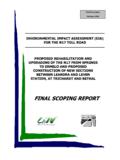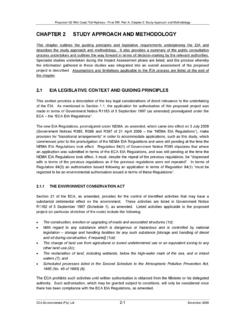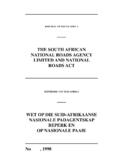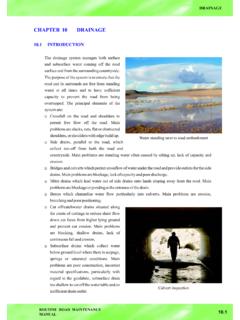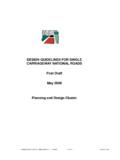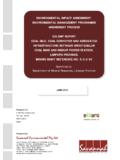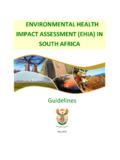Transcription of Scoping Report N17 final - nra.co.za
1 EENNVVIIRROONNMMEENNTTAALL IIMMPPAACCTT AASSSSEESSSSMMEENNTT ((EEIIAA)) FFOORR TTHHEE NN1177 TTOOLLLL RROOAADD PPRROOPPOOSSEEDD RREEHHAABBIILLIITTAATTIIOONN AANNDD UUPPGGRRAADDIINNGG OOFF TTHHEE NN1177 FFRROOMM SSPPRRIINNGGSS TTOO EERRMMEELLOO AANNDD PPRROOPPOOSSEEDD CCOONNSSTTRRUUCCTTIIOONN OOFF NNEEWW SSEECCTTIIOONNSS BBEETTWWEEEENN LLEEAANNDDRRAA AANNDD LLEEVVEENN SSTTAATTIIOONN,, AATT TTRRIICCHHAARRDDTT AANNDD BBEETTHHAALL FFIINNAALL SSCCOOPPIINNGG RREEPPOORRTT Third Document, February 2002 i PPUURRPPOOSSEE OOFF TTHHIISS DDOOCCUUMMEENNTT The South African National Roads Agency Limited (NRA) proposes to declare the existing N17 between Springs and Ermelo as a national road and charge toll fees to cover construction and future maintenance costs. The proposed project will involve the improvement of certain sections of the N17 between Springs and Ermelo, together with the construction of new sections and toll plazas.
2 An environmental impact assessment (EIA) is being done by L&W environmental , an independent company, to evaluate the potential environmental and social impacts of the proposed project. The EIA is being done in terms of the EIA Regulations under Section 21 of the Environment Conservation Act, 1989 (stakeholders are welcome to request a copy of the full EIA Regulations from the public participation office). The first phase of an EIA is the Scoping Phase (see Figure 1 below). This is the phase during which public issues and concerns must be identified so that relevant issues can be evaluated by the EIA technical specialists during the next phase (the impact assessment Phase) of the EIA. The EIA Regulations make provision for authority consideration based on the Scoping Phase of the EIA. Therefore this final Scoping Report and its accompanying Issues and Response Report serves the following purpose: An introduction to the EIA that is being carried out for the proposed N17 toll road between Springs and Ermelo.
3 A description of the regulatory framework for the EIA. Description of the proposed project. The project alternatives that were considered. A description of the way in which the interested and affected parties (I&APs) or stakeholders have been involved. To list all issues raised by stakeholders to date. To indicate whether all their concerns and suggestions have been considered to date. Stakeholders could comment on the Draft Scoping Report in the following ways: Completing the comment sheet enclosed with the Report Additional written submissions Comment by email or telephone Attending the Open Day held in Secunda on 5 December 2001 AN EIA CONSISTS OF SEVERAL PHASES Scoping Phase To identify issues, to focus the EIA impact assessment Phase Detailed studies of potential impacts, positive and negative environmental impact Report Consolidate findings of impact assess-ment studies Decision-Making Phase Proponent and authorities use EIA findings to decide if project goes ahead Figure 1.
4 An environmental impact assessment consists of various phases. The EIA for the proposed N17 toll road project is currently in the Scoping Phase. This is the first phase of the EIA during which issues are raised that must be evaluated during the next phase. ii PPUUBBLLIICC PPLLAACCEESS WWHHEERREE TTHHEE DDRRAAFFTT SSCCOOPPIINNGG RREEPPOORRTT WWAASS AAVVAAIILLAABBLLEE FFOORR PPUUBBLLIICC SSCCRRUUTTIINNYY The Draft Scoping Report was distributed to everyone that requested to be kept informed about this proposed project in response to invitations distributed in October 2001. Copies of this Report were distributed for comment as follows: Left in the following public places: local libraries in the towns of Springs, Leandra, Kinross, Secunda, Bethal, Trichardt and Ermelo, as well as offices of the local councils Proactively mailed to all key stakeholders the authorities and local land owners In addition a Summary Draft Scoping Report was distributed as follows: Proactively mailed to all 400 stakeholders Public places as listed above EENNQQUUIIRRIIEESS PPUUBBLLIICC PPAARRTTIICCIIPPAATTIIOONN OOFFFFIICCEE Toni Pietersen or Qondile Sibiya L&W environmental P O Box 95823 WATERKLOOF, 0145 Tel: (012) 362 0848 Fax: (012) 362 0869 Email: iii TTAABBLLEE OOFF CCOONNTTEENNTTSS environmental impact assessment (EIA) FOR THE N17 TOLL ROAD I 1.
5 INTRODUCTION AND OVERVIEW 1 Who is conducting the EIA? 1 Motivation for the proposed project 2 Project feasibility 2 Legal requirements for Scoping 2 2. BACKGROUND TO THE PROPOSED PROJECT 3 History and National Road Agency (NRA) involvement 3 Consideration of alternatives 4 Route alignment alternatives 4 Technology alternatives 7 The no-action alternative 7 Planned project scheduling 7 3. DESCRIPTION OF THE PROPOSED ROUTE 8 Springs to Leandra 8 Leandra to Kinross 8 Kinross to Trichardt 8 At Trichardt 9 Trichardt to Bethal 9 At Bethal 9 Bethal to Ermelo 9 4. PLANNED PROJECT ACTIVITIES 9 Pre-construction phase 9 Demarcation of servitude 9 Transport of material to site 10 Establishment of construction camps 10 Establishment of crusher plants 11 Construction phase 11 Structures 11 Earthworks 11 Borrow pit establishment 11 Road construction 11 Site removal and rehabilitation 12 Operational Phase 12 Road maintenance 12 5.
6 THE environmental assessment PROCESS 12 Technical process followed during the Scoping phase of the EIA 12 Public participation process followed during the Scoping exercise 13 Objectives of public participation process 13 Stakeholder composition 14 Announcing the opportunity to participate 14 Stakeholder briefings and community consultation 14 Raising issues for investigation by EIA specialists 15 Review of the Draft Scoping Report and Issues and Response Report 15 final Scoping Report and Issues and Response Report 16 Ongoing progress feedback 16 iv 6. DESCRIPTION OF RECEIVING ENVIRONMENT 17 Physical characteristics 17 Climate 17 Geology 17 Soils 17 Hydrology 17 Air quality 17 Fauna and flora 17 Sensitive areas 18 Visual and noise aspects 18 Noise 18 Aesthetics 18 Sites of cultural importance 18 Land use 19 Socio economic issues 19 Security 19 Sub-division of farms 19 7.
7 ISSUES TO BE ADDRESSED IN THE impact assessment PHASE 19 What this chapter contains 19 Issues raised 20 Land value and agricultural viability 20 Socio-economic and social issues 20 Route alignment 21 Impacts on the local ecology 21 Mineral rights 21 Security, safety and access to the proposed toll road 21 Noise, air quality and aesthetics 22 Integration with planned regional, industrial and local developments. 22 8. ASPECTS TO BE COVERED BY SPECIALIST ASSESSMENTS 22 Noise 23 Social assessment 23 Wetlands 23 Soils 23 Geohydrology 23 LIST OF FIGURES Figure 1. An environmental impact assessment consists of various phases. The EIA for the proposed N17 toll road project is currently in the Scoping Phase. This is the first phase of the EIA during which issues are raised that must be evaluated during the next phase.
8 I Figure 2. The proposed N17 route stretches from Springs, Gauteng to Ermelo, 4 EIA FOR THE PROPOSED N17 TOLL ROAD final Scoping Report 4715/2728/4/E 1 IINNTTRROODDUUCCTTIIOONN AANNDD OOVVEERRVVIIEEWW The South African National Roads Agency (NRA) has been responsible for the maintenance, upgrading and operation of the national road network since its establishment in 1998. The NRA receives an annual allocation from the country s national budget to maintain, upgrade and operate approximately 7 000km of roads in South Africa. However, these funds are not sufficient to operate all the national roads under the jurisdiction of the NRA, nor to build the new roads required by the country for economic growth. In line with Government policy, the NRA therefore makes use of the user-pay principle where appropriate for the upgrading, maintenance and expansion of the national road system.
9 The approximately 2000km of toll roads serviced by 50 toll gates, introduced since the early 1980 s, are examples of this strategy representing a total capital improvement in excess of R12 billion. The NRA s proposal to declare the N17 from Springs to Ermelo as a national road and charge toll fees to cover construction and future maintenance costs in a total length of approximately 164 kilometres with toll plazas at three possible locations along this route is a further development of this strategy which will enable the provinces of Gauteng and Mpumalanga to allocate scarce funding to improvements on their remaining road network. The proposed project will involve the improvement of certain sections of the N17 between Springs and Ermelo, together with the construction of new sections and toll plazas. The N17 currently runs in an east/west direction, joining the N3 east of Johannesburg and ending at the Oshoek Border Post, between Swaziland and South Africa.
10 The proposed toll road will thus traverse the provinces of Gauteng and Mpumalanga. In terms of the Environment Conservation Act, 1989 (Act No. 73 of 1989), an environmental impact assessment (EIA) must be undertaken before construction can begin. The EIA must ensure that environmental consequences are considered at all stages of the project. In addition, the EIA will assist the NRA and its consulting engineers to design a road based on sound environmental principles. It should be remembered that the term environment in the context of an EIA refers to the biological, physical, economic and social environments. The initial phase of the EIA is a Scoping exercise. This defines the nature and extent of the impact assessment required. A Draft Scoping Report was circulated to key stakeholders and authorities and a Summary Draft Scoping Report was mailed to all stakeholders on the N17 database and their comments are included in this final Scoping Report .
